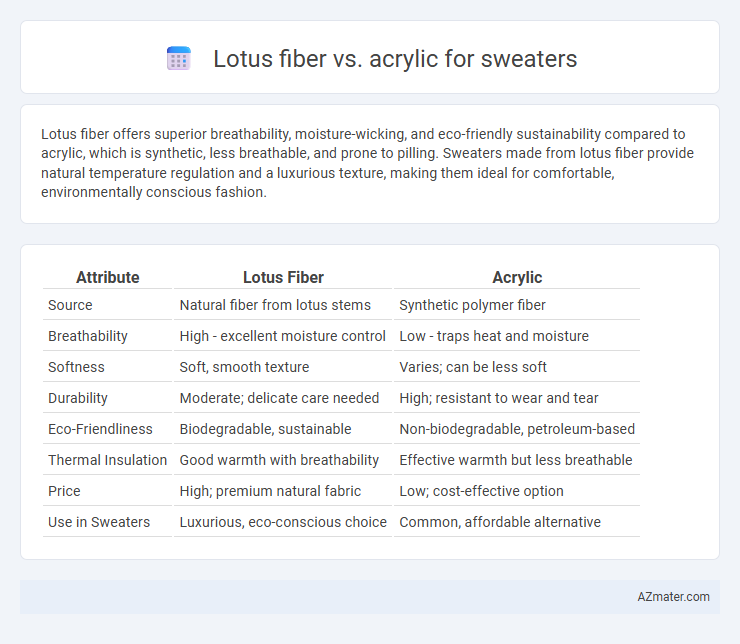Lotus fiber offers superior breathability, moisture-wicking, and eco-friendly sustainability compared to acrylic, which is synthetic, less breathable, and prone to pilling. Sweaters made from lotus fiber provide natural temperature regulation and a luxurious texture, making them ideal for comfortable, environmentally conscious fashion.
Table of Comparison
| Attribute | Lotus Fiber | Acrylic |
|---|---|---|
| Source | Natural fiber from lotus stems | Synthetic polymer fiber |
| Breathability | High - excellent moisture control | Low - traps heat and moisture |
| Softness | Soft, smooth texture | Varies; can be less soft |
| Durability | Moderate; delicate care needed | High; resistant to wear and tear |
| Eco-Friendliness | Biodegradable, sustainable | Non-biodegradable, petroleum-based |
| Thermal Insulation | Good warmth with breathability | Effective warmth but less breathable |
| Price | High; premium natural fabric | Low; cost-effective option |
| Use in Sweaters | Luxurious, eco-conscious choice | Common, affordable alternative |
Introduction to Lotus Fiber and Acrylic
Lotus fiber is a rare, eco-friendly natural textile derived from lotus stems, known for its breathability, lightweight texture, and moisture-wicking properties, making it ideal for sustainable sweaters. Acrylic, a synthetic fiber made from polymer compounds, mimics wool's softness and warmth but lacks natural breathability and eco-friendliness. Choosing between lotus fiber and acrylic impacts sweater comfort, durability, and environmental sustainability.
Origin and Production Processes
Lotus fiber is derived from the stems of the lotus plant, primarily harvested in regions like Myanmar and India, where the fibers are manually extracted by soaking and gently combing the plant stalks. Acrylic fiber, on the other hand, is synthetic, produced through a chemical process called polymerization involving acrylonitrile monomers, predominantly manufactured in industrial facilities worldwide. The natural, labor-intensive extraction of lotus fiber contrasts sharply with the mass-produced, petrochemical origin of acrylic fibers, impacting sustainability and texture in sweater production.
Environmental Impact Comparison
Lotus fiber is a sustainable, biodegradable material derived from lotus stems, requiring minimal water and no harmful chemicals during processing, which significantly reduces its environmental footprint compared to conventional fibers. Acrylic, a synthetic fiber made from petrochemicals, is non-biodegradable and contributes to microplastic pollution in oceans, while its production involves energy-intensive processes and releases greenhouse gases. Choosing lotus fiber over acrylic for sweaters supports eco-friendly textile manufacturing and reduces long-term environmental pollution.
Softness and Comfort Differences
Lotus fiber offers exceptional softness and breathability compared to acrylic, creating a naturally smooth texture that feels gentle against the skin. Acrylic fibers tend to be less breathable and can sometimes cause discomfort due to their synthetic nature, trapping heat and moisture. Choosing lotus fiber for sweaters enhances comfort by providing lightweight warmth with superior moisture-wicking properties, making it ideal for sensitive skin.
Durability and Longevity
Lotus fiber offers exceptional durability due to its natural strength and resistance to wear, maintaining fabric integrity over extended use. Acrylic fibers, while affordable and lightweight, tend to pill and degrade faster with repeated washing and friction. The longevity of sweaters made from lotus fiber surpasses acrylic, making them a more sustainable and long-lasting choice for cold-weather clothing.
Breathability and Moisture Management
Lotus fiber offers superior breathability compared to acrylic, allowing air to circulate freely and keeping the wearer cool and comfortable. Its natural moisture-wicking properties efficiently manage sweat by absorbing and releasing moisture, reducing dampness on the skin. Acrylic, while durable and lightweight, tends to trap heat and moisture, making it less effective for temperature regulation and moisture management in sweaters.
Allergenicity and Skin Sensitivity
Lotus fiber is naturally hypoallergenic and highly breathable, making it ideal for individuals with sensitive skin or allergies, whereas acrylic is synthetic and may cause irritation or allergic reactions in sensitive users. The natural properties of lotus fiber help reduce skin inflammation and discomfort, offering superior comfort for those prone to eczema or dermatitis. Acrylic fibers can trap heat and moisture, potentially exacerbating skin sensitivity and causing itchiness or rashes.
Cost and Accessibility
Lotus fiber sweaters tend to be more expensive due to the labor-intensive extraction process and limited production, making them less accessible in mainstream markets. Acrylic sweaters are widely available and cost-effective, benefiting from large-scale synthetic manufacturing and lower material costs. Consumers seeking affordable, readily accessible options often prefer acrylic, while those valuing sustainability and exclusivity may invest in lotus fiber garments.
Care and Maintenance Requirements
Lotus fiber sweaters require gentle hand washing or dry cleaning to maintain their natural softness and durability, avoiding harsh detergents and direct sunlight to prevent fiber damage. Acrylic sweaters are more resilient to machine washing and can withstand regular cycles but may pill over time, necessitating occasional use of a fabric shaver for upkeep. Proper drying methods, such as flat drying for lotus fiber and tumble drying on low heat for acrylic, help preserve the shape and longevity of each sweater type.
Conclusion: Which Is Better for Sweaters?
Lotus fiber offers superior breathability, sustainability, and natural moisture-wicking properties, making it ideal for eco-conscious and comfort-focused sweaters. Acrylic provides affordability, durability, and ease of care but lacks the natural softness and environmental benefits of lotus fiber. Choosing lotus fiber ensures a luxurious, breathable sweater with a smaller ecological footprint, while acrylic suits budget-friendly, low-maintenance options.

Infographic: Lotus fiber vs Acrylic for Sweater
 azmater.com
azmater.com